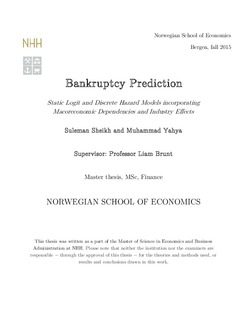Bankruptcy prediction : static logit and discrete hazard models incorporating macoreconomic dependencies and industry effects
Abstract
In this thesis, we present firm default prediction models based on firm financial statements
and macroeconomic variables. We seek to develop reliable models to forecast out-of-sample
default probability, and we are particularly interested in exploring the impact of
incorporating macroeconomic variables and industry effects. To the best of our knowledge,
this is the first study to account for both macroeconomic dependencies and industry effects
in one analysis. Additionally, we investigate the impact of the 2008 financial crisis on
bankruptcies.
We develop five models, one static logit model and four hazard models, and compare the
out-of-sample predictive performance of these models. To explore the impact of industry
effects and the financial crisis, our study includes 562 U.S. public companies across all
sectors (except financial) that filed for bankruptcy between 2003 and 2013. These were
matched to a control group of non-bankrupt firms.
We find that the cash flow, profitability, leverage, liquidity, solvency, and firm size are all
significant determinants of bankruptcy. The ratio of cash flow from operations to total
liabilities, and total debt to total assets, are the most significant variables in the static logit
model. In addition to these ratios, cash to total assets and net income to total assets are
also among the most important covariates in the hazard models. Next, we find that the
forecasting results are improved by incorporating macroeconomic variables. Finally, we find
that the hazard model with macroeconomic variables and industry effects has the best outof-sample
accuracy.
